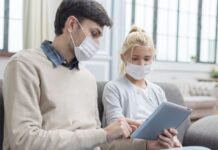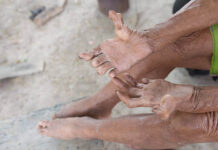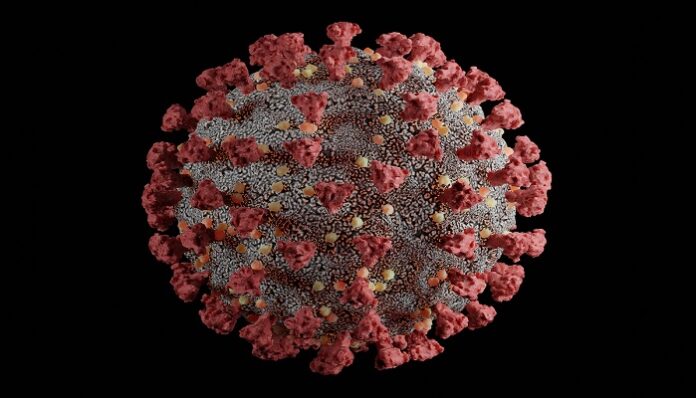Abstract
The third wave of COVID-19 due to the Omicron variant has started in India. Being highly infective, there is an exponential increase in the number of daily cases. At this time, urgent steps are needed to minimise community transmission and thereby, protect healthcare workers (HCW) from being infected, which could result in disastrous consequences for the ultimate management of seriously ill patients. Apart from observing Covid appropriate behaviour, we have measures such as vaccines, targeted antivirals and monoclonal antibodies to prevent serious disease, whose efficacy need to be established. Systematic planning, adequate stock of oxygen, essential drugs like steroids and blood thinners will go a long way in tiding over this third wave too.
Introduction
Epidemiologists are trying to say, ‘Easy, tiger. This could be bad. This could be very bad.’ But we don’t know enough to roll that tape forward.” – William Hanage
On the 26th of November 2021, the World Health Organisation (WHO) named the B.1.1.529 variant of the Coronavirus (Omicron) as a ‘Variant of Concern.’ Although labelled as a milder virus than the Delta variant, the Omicron virus is spreading faster than any other virus till now. Even though patients with the Omicron virus are 50%-70% less likely to get hospitalized, the emergence of the third wave does make it mandatory for the medical professionals to prepare adequately in advance for the war against this virus so that we do not face again the life-threatening complications due to the deficiency of oxygen, medicines or hospital beds that was seen during the first and the second wave of COVID-19 resulting in high morbidity and mortality among the health care workers.
Omicron Control Steps:
A. Vaccination
Although vaccination remains the main source of protection against Omicron, research is ongoing as to how protected the fully vaccinated people will be against infection, hospitalization, and death. Though vaccines help teach the body how to fight Covid, the current vaccines in use like Covishield or Covaxin were not designed to combat the heavily mutated Omicron variant, meaning they may not be a perfect match. According to a non-peer reviewed study from UK on a sample size of 169,888 Delta cases and 204,036 Omicron cases with 2 doses of AstraZeneca (ChAdOx1-S) vaccine as the primary course and Pfizer (BNT162b2) or Moderna (mRNA-1273) as a booster, it was seen that a third dose of Covid-19 vaccine can boost a person’s resistance to Omicron variant of coronavirus by as much as 88%.[1] The study showed that there is an 81% reduction in the risk of hospitalisation after three doses as against unvaccinated patients. Among those who had received 2 doses of AstraZeneca, there was no effect against Omicron from 20 weeks after the second dose. However, in those who had received 2 doses of Pfizer or Moderna, effectiveness dropped from around 65 to 70% down to around 10% by 20 weeks after the second dose.
B. Covid Appropriate Behaviour
With Omicron having a significant growth advantage over Delta, spreading fast through communities with a doubling time of between 1.5 and 3 days, it is of utmost importance to wear a well-fitting mask, avoidance of indoor meets or parties, maintain physical distancing, maintain hand hygiene, refrain from going to crowded places and maintain proper ventilation in the environment.[2] According to the ACGIH’s Pandemic response task force, it has been shown that when a well-fitting N95 mask is worn there is protection against infection for nearly 2500 hours.[3]
C. Travel Restrictions
Although a blanket travel ban does not have any evidence supporting the prevention of the spread of the virus, travel restrictions done initially do allow slowing down of virus transmission. Prof Mark Woolhouse from UK remarked that travel restrictions were “a case of shutting the stable door after the horse has bolted.” However, WHO did recommend unvaccinated people vulnerable to Covid-19, including over-60s, to avoid travel to areas with community transmission of the virus.[4] Non–essential travel should be avoided.
D. Drugs
Although there is no evidence-based drug of proven efficacy against Omicron, three drugs have been permitted for oral and intravenous infusion use. Molnupiravir is an antiviral pill developed by Merck & Co, that inserts tiny errors into the coronavirus’ genetic code to stop it from reproducing. A randomised double blind placebo controlled phase-3 study, to evaluate the efficacy and safety of treatment with molnupiravir started within 5 days after the onset of signs or symptoms in non-hospitalized, unvaccinated adults with mild-to-moderate, laboratory-confirmed Covid-19 and at least one risk factor for severe Covid-19 illness, showed that the risk of hospitalisation or death through day 29 was lower with Molnupiravir.[5] While Merck is yet to test its drug against the Omicron variant, the pharma company said that it should have some potency based on its effectiveness against other strains of coronavirus. Nevertheless, Indian Council of Medical Research has still not approved Molnupiravir in the treatment protocol due to major safety concerns like teratogenicity, mutagenicity and cartilage or muscle damage.[6]
Paxlovid is another antiviral therapy, developed by Pfizer which is designed to block the activity of the SARS-CoV-2 protease, an enzyme that the coronavirus needs to replicate. Results from phase-II, III clinical trials showed that Paxlovid reduced the risk of hospitalisation or death by 89%. Pfizer claims that Paxlovid appears effective against the new Omicron variant.[7] Finally, another drug which is used for mild to moderate disease in patients with high risk of developing severe Covid 19 disease is a combination of two monoclonal antibodies, Casirivimab and Imdevimab developed jointly by Roche and Regeneron. The cocktail has been designed to block the infectivity of SARS-CoV-2, by binding to the critical receptor binding domain of the virus’s spike protein. It was reported that the antibody cocktail significantly reduced viral load within 7 days of treatment in seronegative patients and who required low-flow or no supplemental oxygen.[8]
However, the efficacy of this cocktail against Omicron variant is still not established.[9]
E. Genome Sequencing
The Indian Council of Medical Research (ICMR) has approved an indigenous testing kit for detecting the Omicron variant of the SARS-CoV-2 coronavirus. The kit is manufactured by Tata Medical and Diagnostics and is named OmiSure which will be used to confirm Omicron in patients with its S-Gene Target Failure (SGTF) strategy.[10] Omicron has been found in 65% of samples in Delhi in the latest genome sequencing reports. Sequencing initiatives in a systematic and comprehensive manner is highly recommended to study the evolution and mutations of the virus.[11] It is mandatory to have enhanced surveillance with rapid testing for Covid-19 and stricter contact tracing of cases suspected to be infected with the virus to interrupt chains of transmission.
F. Hospital Beds and Oxygen Audit
Government of India has directed to review and monitor the status of oxygen concentrators, ventilators, oxygen cylinders, Liquid Medical Oxygen (LMO) plants and Medical Gas Pipeline Systems (MGPS) daily to ensure that the gap between the equipment and systems delivered to the districts and installed at the healthcare facilities is reduced to zero.[12] All hospitals need to start Flu clinics and prepare adequate inpatient beds, ventilators, PPE and keep essential drugs like steroids, paracetamol and blood thinners ready in case of an acute surge of Omicron cases. While there is no doubt that serious and complicated cases need prior preparedness and planning, it is also important that panic and anxiety as well as unnecessary hospitalizations should be avoided. Indiscriminate and unethical use of steroids, antivirals, antibiotics and blood thinners should be prohibited. Pandemic profiteering should be strictly banned.[13]
G. Home Care
The Ministry of Health and Family Welfare, India has recommended 7 days home quarantine for mild or asymptomatic positive cases whose oxygen saturation at room temperature is more than 93%. It is essential to choose one person in the household as the main care taker in home isolation who should be vaccinated and must wear an N-95 mask always. There should be a facility for free online and phone consultation with the primary care physician.
H. Telemedicine and Apps
WHO chief scientist Soumya Swaminathan predicted that as there might be an Omicron surge and probably that time has come. So, ‘maybe, this is the time to really scale up and effectively use telehealth and telemedicine services to make sure we have enough doctors and nurses in out-patients’ clinics; make sure we can treat people at home as much as possible or at primary care centres.’[14] The Karnataka State Remote Sensing Application Centre is developing a special ‘Quarantine Watch App’ for monitoring such patients.
I. Stopping Elective Surgery
Omicron variant is forcing the U.S. National Institutes of Health to postpone elective surgeries as a growing number of infected staff must isolate or quarantine. It has been estimated that Omicron may cause 100,000 cancelled operations in England this winter adding to the huge backlog of delayed treatment.[15]
J. Mental Health of Health Care Workers
Health care workers are already having ‘Pandemic fatigue’ dealing with the first and the second wave of Covid-19 and now with the onset of Omicron cases, Covid-19 burnout among health care professionals is making things difficult and the anxiety, panic and depression may lead to an overall increase in cases. It was seen that ‘doomscrolling,’ or intentionally tuning in to negative stories on TV or social media, fuels increased dread, uncertainty, anxiety, and fatigue and so doomscrolling should stop immediately and every health care professional should try to create their own ‘Covid bubble’ with a group of like-minded family members or friends to socialize who take similar precautions which may be helpful for a robust mental health during the Omicron pandemic.[16]
K. Medical Staff Shortage
Rochelle P. Walensky, Director of the Canter for Disease Control and Prevention (CDC) commented “While in prior waves, we’d seen ventilators being scarce, supply of dialysis machines and ICU beds, so much of what’s happening with Omicron is actually the scarcity of the health-care workforce itself.”[17] Since there is going to be more health care workers getting affected with Omicron due to its high infectivity as compared to the Delta virus, there is always a worry that rushing infected colleagues back to their jobs could pose new risks, such as spreading the virus to uninfected workers and patients. Hospitals must invest in the safety of their workers by providing them with N-95 masks, PPE and constant encouragement and counselling to follow safety protocols.
Conclusion
With the surge of Omicron cases starting in India, based on its R value, the wave is expected to peak in February 2022. So it is of paramount importance that adequate precautions are taken in the coming days, to limit the effects of the wave. Even a small percentage of hospitalization and mortality will result in huge number of deaths in our country, and sick people coming to the hospital would be on the rise. It is very important that health care workers already burdened by Covid fatigue be motivated to take adequate precautions so that we have specialist care available at this time. The bottom-line remains primary 2 dose vaccination completion on priority basis followed by immediate booster shots on priority basis for the health care workers and high risk groups.
A third booster dose of vaccine for HCW should be started on a war footing. “Vaccines remain the number one, two, three, four, and five tool to stop this pandemic”- Dr. Michael Osterholm.
References
- Asset publishing [Internet] UK Health Security Agency [cited 2021 Dec 10]. Available from:https://assets.publishing.service.gov.uk/government/uploads/system/uploads/attachment_data/file/1044481/Technical-Briefing-31-Dec-2021-Omicron_severity_update.pdf
- World Health Organisation [Internet] Enhancing Readiness for Omicron (B.1.1.529): Technical Brief and Priority Actions for Member States [ cited 2021 Dec 17]. Available from: https://www.who.int/docs/default-source/coronaviruse/20211217-global-technical-brief-and-priority-action-on-omicron_latest-2.pdf?sfvrsn=bdd8297c_12
- Pandemic Response Task Force [internet]. Covid 19: Workers need respirators. Available from: https://www.acgih.org/covid-19-fact-sheet-worker-resp/
- NDTV Coronavirus [Internet]. WHO Warns Against “Blanket” Omicron Travel Bans As Nations Shut Borders [cited 2021 Dec 1]. Available from:https://www.ndtv.com/world-news/coronavirus-who-warns-against-blanket-omicron-travel-bans-as-nations-shut-borders-2631480
- Jayk Bernal A, Gomes da Silva MM, Musungaie DB, et al. Molnupiravir for oral treatment of Covid-19 in nonhospitalized patients. N Engl J Med. 2021 Dec. doi: 10.1056/NEJMoa2116044.
- Economic Times [Internet]. Covid antiviral drug Molnupiravir has ‘major safety concerns’, says ICMR [ cited 2022 Jan 6]. Available from:https://economictimes.indiatimes.com/industry/healthcare/biotech/pharmaceuticals/covid-antiviral-drug-molnupiravir-has-major-safety-concerns-icmr/articleshow/88715891.cms?from=mdr
- Mahase E. Covid-19: Pfizer’s paxlovid is 89% effective in patients at risk of serious illness, company reports BMJ. 2021;375:n2713. doi:10.1136/bmj.n2713
- European Pharmaceutical Review [Internet] Ronapreve™ reduces COVID-19 viral load within seven days [cited 2021 Sept 30]. Available from:https://www.europeanpharmaceuticalreview.com/news/163468/ronapreve-reduces-covid-19-viral-load-within-seven-days/
- Roche. Ronapreve does not retain neutralising activity against the Omicron variant [Internet]. 2021 [cited 2021 Dec 17]. Available from: https://www.roche.com/dam/jcr:dfe6dcb4-d787-45d6-9b1dffc17d667e4c/2021216_Roche%20statement%20on%20Ronapreve%20Omicron.pdf
- The Hindu [Internet]. ICMR approves India-made kit to detect Omicron [cited 2022 Jan 4]. Available from:https://www.thehindu.com/news/national/icmr-approves-india-made-kit-to-detect-omicron/article38112784.ece
- Kandeel M, Mohamed MEM, Abd El-Lateef HM, Venugopala KN, El-Beltagi HS. Omicron variant genome evolution and phylogenetics. J Med Virol. 2021 Dec 10. doi: 10.1002/jmv.27515. Epub ahead of print.
- India.com [Internet]. Ensure No Gap in Oxygen Supply: With Omicron Cases Rising, States, UTs Asked to Stay Prepared to Deal with Emergency [cited 2021 Dec 16]. Available from:https://www.india.com/news/india/ensure-no-gap-in-oxygen-supply-with-omicron-cases-rising-states-uts-asked-to-stay-prepared-to-deal-with-emergency-5141607/
- Bhattacharya K, Bhattacharya N. Pandemic profiteering during the second wave of Covid-19. Indian Journal of Medical Ethics(2021) online. DOI: https://doi.org/10.20529/IJME.2021.087,
- Deccan Herald [Internet]. Omicron led surge will be ‘very fast’ warns WHO expert [cited 2022 Jan 1]. Available from: https://www.deccanherald.com/national/omicron-led-surge-will-be-very-fast-warns-who-expert-1066789.html
- COVIDSurg Collaborative. Projecting COVID-19 disruption to elective surgery. Lancet. 2021 Dec 16;S0140-6736(21)02836-1. doi: 10.1016/S0140-6736(21)02836-1. Epub ahead of print.
- First Post [Internet]. How to combat pandemic fatigue in 2022? Stop room scrolling, seek help and maintain hope. [cited 2022 Jan 3]. Available from :https://www.firstpost.com/health/how-to-combat-pandemic-fatigue-in-2022-stop-doomscrolling-seek-help-and-maintain-hope-10253111.html
- Washington Post. [Internet]. First they ran short of PPE, then ventilators. Now, the shortage is hospital staff.[cited 2021 Dec 30]. Available from: https://www.washingtonpost.com/health/2021/12/30/hospitals-staffing-shortages-omicron/
+

























